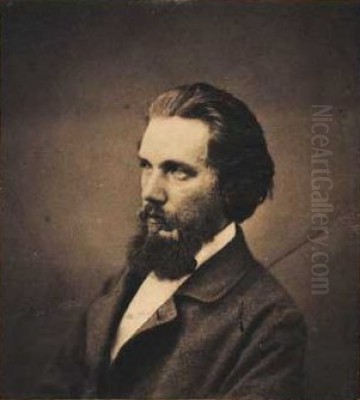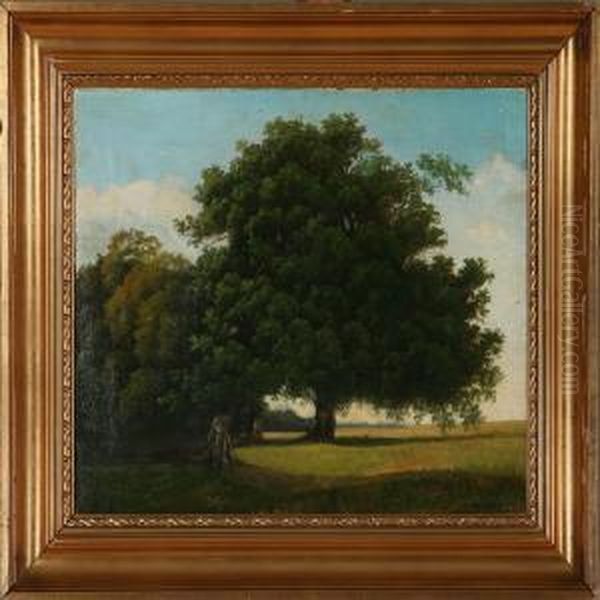
Axel Thorsen Schovelin (1827-1893) stands as a significant, if sometimes overlooked, figure within the rich tapestry of 19th-century Danish art. A dedicated landscape painter, he operated during the latter part of what is famously known as the Danish Golden Age of Painting, a period characterized by a burgeoning national identity and a profound artistic exploration of Denmark's natural beauty and everyday life. Schovelin's work, primarily executed in oils, masterfully blended the prevailing currents of Romanticism with an emergent Realism, capturing the serene and often subtle charm of the Danish countryside, particularly the environs of his native Copenhagen.
Early Life and Artistic Inclination
Born in Copenhagen on May 27, 1827, Axel Thorsen Schovelin exhibited artistic promise from a remarkably young age. The Danish capital at this time was a vibrant hub of cultural and intellectual activity, still basking in the glow of the early Golden Age luminaries. It was an environment conducive to nurturing artistic talent. His innate ability for drawing and keen observation of nature led him, at the tender age of twelve, to enroll in the prestigious Royal Danish Academy of Fine Arts in 1839. This early entry into formal artistic training was a testament to his precocious talent and dedication.
The Academy, under the enduring influence of figures like Christoffer Wilhelm Eckersberg, often dubbed the "Father of Danish Painting," emphasized meticulous observation, strong draftsmanship, and a deep respect for nature. While Eckersberg's direct professorship was nearing its end by the time Schovelin was a more advanced student, his pedagogical principles permeated the institution. Schovelin began exhibiting his works at the Academy's annual Charlottenborg Spring Exhibition while still a student, quickly gaining recognition for his sensitive portrayals of the Danish landscape.
The Danish Golden Age Context

To fully appreciate Schovelin's contribution, one must understand the Danish Golden Age (roughly 1800-1850, with its influence extending further). This era saw artists turn inward, partly as a response to national crises like the Napoleonic Wars, the bombardment of Copenhagen, and the loss of Norway. There was a collective desire to define and celebrate Danish identity. Painters like Christen Købke, Constantin Hansen, Wilhelm Bendz, and Martinus Rørbye focused on portraits, genre scenes, architectural studies, and, crucially, landscapes, all imbued with a sense of quiet dignity and national pride.
Landscape painting, in particular, became a vehicle for expressing a deep connection to the homeland. Artists ventured into the Danish countryside, meticulously documenting its forests, fields, coastlines, and the unique quality of Nordic light. Figures like P.C. Skovgaard and Johan Thomas Lundbye became leading exponents of this national landscape tradition, often infusing their works with a Romantic sensibility that highlighted the sublime or picturesque aspects of nature, while still grounding them in careful observation. Schovelin emerged in the wake of these masters, inheriting their dedication to the Danish landscape.
Artistic Development and Influences
Schovelin's artistic development was significantly shaped by his academic training and the prevailing artistic climate. He became adept in oil painting, the preferred medium for capturing the nuanced textures and light of the Danish scenery. His style evolved to incorporate a sensitive blend of Romanticism's emotional depth and Realism's fidelity to visual truth. Unlike the more dramatic or idealized landscapes of some earlier Romantics, Schovelin's work often possessed a more intimate and tranquil quality.
His talent did not go unnoticed by the Academy, which awarded him several scholarships. These grants provided him with opportunities to travel abroad, notably to Germany and France. Such journeys were common for promising Danish artists, offering exposure to different artistic traditions and contemporary movements. In Germany, he would have encountered the legacy of German Romanticism, perhaps the works of artists like Caspar David Friedrich (though Friedrich's main impact was earlier) or the Düsseldorf school of painting, known for its detailed landscapes. In France, the Barbizon School, with artists like Jean-Baptiste-Camille Corot and Théodore Rousseau, was championing plein air painting and a more direct, unembellished approach to nature, which would have resonated with the Danish emphasis on observation.
Despite these international experiences, Schovelin’s artistic heart remained firmly rooted in Denmark. His travels seemed to refine his technique and broaden his perspective rather than fundamentally alter his thematic focus. He consistently returned to the landscapes around Copenhagen, finding inexhaustible inspiration in the familiar woods, lakes, and fields. This dedication to local scenery was a hallmark of many Golden Age painters.
Themes and Signature Style
Schovelin's oeuvre is characterized by its consistent focus on the Danish landscape. He was particularly drawn to the areas surrounding Copenhagen, such as Jægersborg Dyrehave (The Deer Park), a vast natural park north of the city, and the various forests and lakes that dotted the Zealand countryside. His paintings often depict tranquil woodland scenes, sun-dappled forest floors, serene lakesides, and quiet rural paths.
His artistic signature lies in his skillful use of color and composition. He had a fine eye for the subtle shifts in light and atmosphere, capturing the specific qualities of the Danish seasons. His compositions are typically well-balanced, leading the viewer's eye into the scene with a sense of calm and order. While Romantic in their appreciation for nature's beauty and mood, his works are also imbued with a Realist's attention to detail – the texture of bark, the reflection in water, the specific foliage of Danish trees. This fusion allowed him to create paintings that were both evocative and believable. He was less inclined towards the overtly nationalistic or historically symbolic landscapes of some of his predecessors, focusing instead on the inherent beauty and peacefulness of the natural world he observed.
Notable Works and Royal Patronage
Among Schovelin's representative works, "By en Dam" (often translated as "By the Pond" or "By a Pond") exemplifies his characteristic style. Such paintings typically showcase his sensitive rendering of water, foliage, and the interplay of light and shadow, creating a serene and inviting atmosphere. These works reflect his deep connection to the specific locales he frequented and painted repeatedly, exploring them under different conditions and at different times of the year.
A significant moment in Schovelin's career came in 1867 when he received a prestigious commission from King Christian IX of Denmark. The King tasked him with creating a painting of the Heidelberg Castle ruins in Germany. This commission was not only a mark of high honor and royal favor but also an acknowledgment of his established reputation as a skilled landscape painter capable of handling significant subjects. The resulting work, "The Castle Ruins," would have required him to apply his landscape skills to a subject rich in historical and Romantic associations, a slight departure from his usual Danish scenes but one that he evidently executed to the satisfaction of his royal patron. This commission also highlights the continued importance of royal and aristocratic patronage for artists in the 19th century.
Other artists of the period also benefited from or sought such patronage, including portraitists like Carl Bloch or historical painters. For a landscape artist like Schovelin, a royal commission for a specific, significant site was a notable achievement.
Personal Life
Axel Thorsen Schovelin's personal life appears to have been relatively stable, providing a supportive backdrop for his artistic endeavors. In 1851, he married Oline Petrine Moesgaard (sometimes recorded as Moos). Their union was blessed with children, including a son, Julius Schovelin, who later became a distinguished economist and politician. This connection to a figure in public life suggests a family environment that valued both artistic and intellectual pursuits.
His life was centered in Copenhagen, the city of his birth, education, and ultimately, his passing. This lifelong association with the capital and its surroundings is deeply reflected in his choice of subject matter. He was part of a community of artists, many of whom, like Vilhelm Kyhn, another contemporary landscape painter, also dedicated their careers to capturing the Danish environment.
Later Career and Artistic Legacy
Schovelin continued to paint and exhibit throughout his life, remaining a respected figure in the Danish art world. He was a consistent contributor to the Charlottenborg exhibitions, the primary venue for Danish artists to showcase their work. While the artistic currents began to shift towards the end of the 19th century with the rise of movements like Symbolism and early Modernism (seen in Denmark with artists like Vilhelm Hammershøi or the Skagen Painters such as P.S. Krøyer and Michael Ancher, who brought a different kind of Realism and Impressionistic light to their coastal scenes), Schovelin remained largely faithful to the Golden Age landscape tradition he had mastered.
His dedication to this tradition, however, does not diminish his importance. He represents a vital continuation and refinement of the landscape ideals established by earlier Golden Age masters. His work provided a bridge between the high Romanticism of Lundbye and Skovgaard and the later, more naturalistic approaches to landscape that would follow. He maintained a high standard of craftsmanship and a genuine love for the Danish scenery that resonated with his contemporaries and continues to be appreciated today.
Axel Thorsen Schovelin passed away in Copenhagen on December 16, 1893, at the age of 66. He left behind a substantial body of work that captures the tranquil beauty of 19th-century Denmark. His paintings are held in various Danish museums and private collections, serving as enduring testaments to his skill and his affection for his native land.
Schovelin in the Broader Context of European Art
While Schovelin was primarily a Danish national painter, his work can be seen within the broader European context of 19th-century landscape painting. The Romantic impulse to find spiritual solace and national identity in nature was a widespread phenomenon, evident in the works of Germany's Caspar David Friedrich, England's John Constable and J.M.W. Turner, and France's Barbizon School. Schovelin's blend of Romantic sensibility with Realist observation aligns with a general trend across Europe where artists sought to depict the world around them with greater fidelity while still imbuing their subjects with emotional or atmospheric qualities.
His focus on specific, local scenery rather than grand, idealized vistas also mirrors a tendency seen elsewhere, where artists increasingly valued the particular character of their own regions. The meticulous attention to detail and light found in Schovelin's work echoes the concerns of many Realist painters, even if his overall mood often leaned towards the gentle Romanticism characteristic of the Danish Golden Age. He may not have achieved the international fame of some of his European contemporaries like Gustave Courbet or Jean-François Millet, who were more radical in their Realism, but his contribution to his national school of painting is undeniable.
Conclusion: An Enduring Vision of Danish Nature
Axel Thorsen Schovelin was a dedicated and skilled practitioner of landscape painting, a quiet yet persistent voice within the Danish Golden Age and its aftermath. His art is a celebration of the subtle, often understated beauty of the Danish countryside. Through his careful observation, his refined technique, and his evident love for his subjects, he created a body of work that offers a peaceful and enduring vision of Denmark's natural heritage.
While perhaps not as revolutionary as some of his predecessors or successors, Schovelin played an important role in maintaining and developing the strong Danish tradition of landscape painting. His works, characterized by their harmonious compositions, sensitive handling of light, and tranquil moods, continue to offer viewers a connection to the 19th-century Danish landscape and the artistic values of a remarkable era in Danish art history. He remains a respected figure, whose paintings provide a valuable window into the soul of Danish nature as perceived through the eyes of a devoted artist.